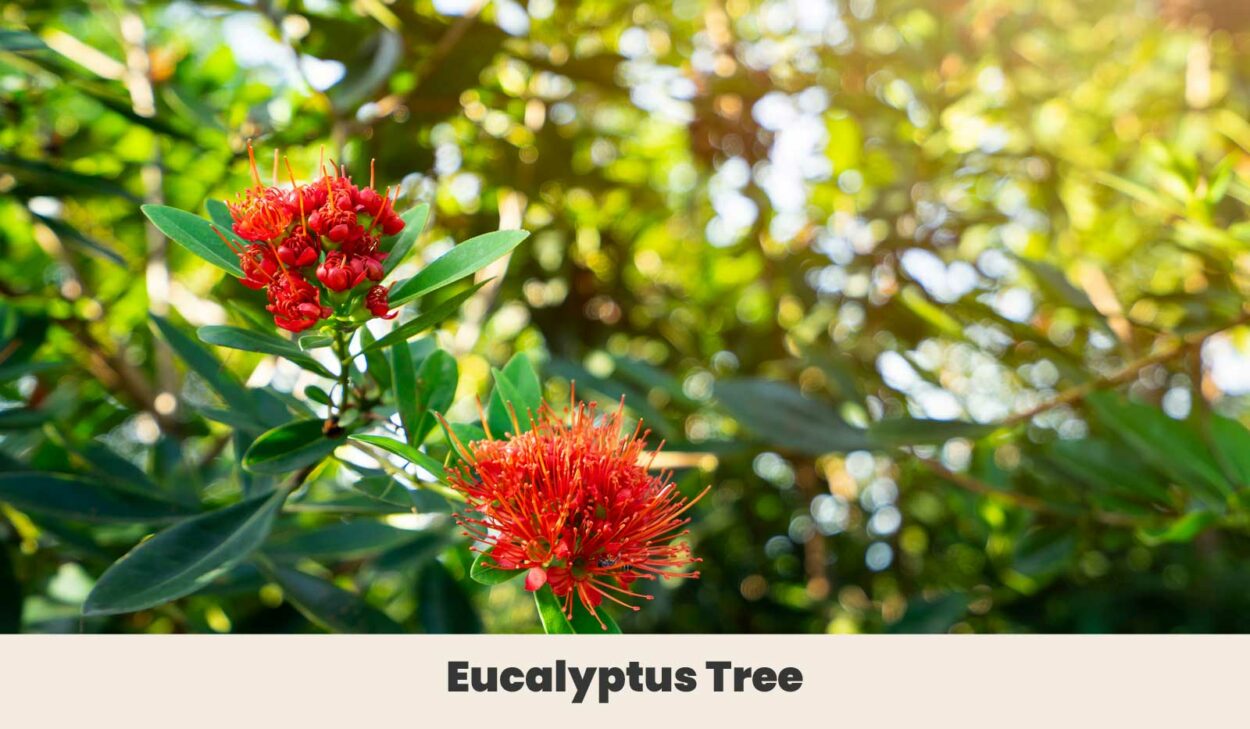11 Stunning Red Flowering Trees for You to Add to Your Garden

This post follows our research editorial guidelines.

Have you ever imagined your outdoor space blossoming with vibrant shades of red? If you’re like me, you’re likely captivated by the charm of these stunning red flowering trees. However, selecting the right one for your garden might feel like you’re walking through a crowded forest.

Plan your landscape now as we discover the charm and charisma of these magnificent trees. From early blooming dogwoods to the everlasting flowers on the bottlebrush tree, lets see which ones will best suit your needs.
Most of the trees here will grow wonderfully next to Orange or Yellow flowering trees based on their hardiness zones and warm color pallets. 🌸
Quickly Find The Red Flowering Tree That You’re Looking For:
1. Red Silk Cotton Tree (Bombax ceiba )

Often used for medicinal purposes, the red flowers on this tree can be tossed into your daily cup of tea. The red silk cotton tree grows quite tall and wide, so ensure you have enough overhead space.
The silk cotton tree gets its name from its billowing blooms that resemble silky cotton clouds. The Bombax ceiba is culturally significant in many of the tree’s native regions and is a popular flower to nearby pollinators like bees and butterflies.
| Botanical Name: | Bombax |
| Growth Rate: | Medium |
| Native Range: | Southeast Asia, Australia |
| Hardiness Zones: | 10-12 |
| Soil Needs: | Sand, Clay soil |
| Exposure: | Full sun |
| Blooming Period: | March-April |
2. Black Diamond Blush Crape Myrtle (Lagerstroemia indica)

This thin but stocky tree grows relatively quickly and is quite the looker. The Black Diamond Blush Crape Myrtle has multiple varieties ranging from bright red flowers to pink and lavender blooms.
This particular variety of Crape Myrtle is known for its stunning dark burgundy foliage that complements and contrasts against the lighter pink and red flowers.
| Botanical Name: | Lagerstroemia indica |
| Growth Rate: | Fast: 24” per year |
| Native Range: | Central Himalayas, South China, Japan, Indonesia |
| Hardiness Zones: | 6-9 |
| Soil Needs: | Clay, loam, sand, shallow rocky, high organic matter |
| Exposure: | Full sun |
| Blooming Period: | June-Fall |
3. Red Dogwood (Cornus Florida var. Rubra)

The Flowering Red Dogwood has got to be one of my favorite trees native to my growing region. While the booming period on this tree is short, the showy blooms are well worth the wait.
Other than the bark of the lower trunk, the entire red dogwood tree is red. Planting this tree is a surefire way to brighten your garden, but it will take some time to grow to its full potential. Make sure you plant this on its own so it doesn’t overpower other plants nearby.
| Botanical Name: | Cornus florida var. rubra |
| Growth Rate: | Medium-fast (12-24” per year) |
| Native Range: | Eastern America, Eastern Mexico, South Eastern Canada |
| Hardiness Zones: | 5-9 |
| Soil Needs: | Can tolerate a wide variety of soil conditions |
| Exposure: | Full sun, partial shade |
| Ease of Care: | Easy |
| Blooming Period: | April-May |
4. Bottlebrush (Callistemon)

The Bottlebrush tree gets its name from the weeping brush-like blooms. It’s perfect for small spaces since it doesn’t grow very wide and is a relatively quick-growing tree that develops red tubular flowers.
Native to Australia, the bottlebrush tree is a common ornamental that is prized for the abundance of nectar the tree provides to hummingbirds and honeyeaters.
The bottlebrush tree is a hardy species that can tolerate a wide range of soil types and weather conditions making it a great choice for a fussy garden.
| Botanical Name: | Callistemon Viminalis |
| Growth Rate: | Low (10” per year) |
| Native Range: | Australia |
| Hardiness Zones: | 9-11 |
| Soil Needs: | Clay, loam or sandy soil |
| Exposure: | Full sun |
| Blooming Period: | Long – all summer |
5. Pomegranate Tree (Punica granatum)

By now, you should be all too familiar with the fruit that comes from a pomegranate tree. Not only does this tree produce bright red fruit, but the blooms are also bright red too.
The pomegranate tree grows at a slow to medium pace. However, giving it the right amount of nutrients and protecting it from fungal infections and bug infestations will reward you with delicious fruit to feast on as you admire your growing garden.
| Botanical Name: | Punica Granatum |
| Growth Rate: | Medium (12-24” per year) |
| Native Range: | North East Turkey to Afghanistan |
| Hardiness Zones: | 8-11 |
| Soil Needs: | Clay, loam, sand |
| Exposure: | Full sun, partial shade |
| Propagation: | Seeds and cuttings |
| Blooming Period: | Short |
6. Eucalyptus Tree (Eucalyptus globulus)

The eucalyptus tree is one of the tallest known species of trees around growing to a staggering height of 55 metres if well cared for.
Eucalyptus trees are commonly used for the essential oils in their leaves although we’re not the only ones who look to harvest from this green giant. A wide range of pollinators prize the eucalyptus tree for its pollen that comes from the red flowers that bloom.
The Eucalyptus Globulus is incredibly fast-growing and quite resilient to pests due to those essential oils we love so much. It does shed a lot, though, so you need to be consistent with upkeep.
| Botanical Name: | Eucalyptus Globulus |
| Growth Rate: | Fast |
| Native Range: | Australia, Tasmania |
| Hardiness Zones: | 8-11 |
| Soil Needs: | Loam, clay |
| Exposure: | Full sun |
| Blooming Period: | Short |
7. Scarlet Rosemallow Hibiscus (Hibiscus coccineus)

The Scarlet Rosemallow Hibiscus is known for its vibrant red flowers and showy blossoms that resemble a star.
The Hibiscus tree is another excellent landscape option especially if your soil type is prone to erosion. Being large size and fast growth rate of this bright red flowering tree make it an excellent option for you if you’re eager to see blooms the first year after planting. Add the Scarlet Rosemallow Hibiscus if you’re looking for a dramatic pop of color to your garden this year.
| Botanical Name: | Hibiscus coccineus |
| Growth Rate: | Fast |
| Native Range: | Southeastern United States |
| Hardiness Zones: | 6-9 |
| Soil Needs: | Moist, well-draining loam, sand |
| Exposure: | Full sun to partial shade |
| Blooming Period: | Long |
8. Indian Coral Tree (Erythrina variegata)

The Indian Coral Tree or Tiger’s Claw is a fast-growing tree that gets quite tall. The brightly colored flowers on this tree are clustered together in dense spikes making a vibrant addition to any garden. Like many other flowering trees on this list, the Indian Coral Tree has flowers that are a favorite among pollinators.
The Erythrina variegata is a captivating species with vibrant red flowers, but to get the most out of this plant, manage water treatment and minor problems like mildew.
| Botanical Name: | Erythrina variegata |
| Growth Rate: | Fast |
| Native Range: | Tropical regions of Asia and Oceania |
| Hardiness Zones: | 9-11 |
| Soil Needs: | Loam, clay, sand, well-draining soil |
| Exposure: | Full-sun |
| Blooming Period: | Medium |
9. Azaleas (Rhododendron)

Azaleas are one of my favorite flowers beginning with A. Azaleas are best grown if you need to fill up a patch in your garden or create a space to combine plants with different colors. Its low profile makes it easy to fit in any area.
Azaleas are known for their long-lasting red flowers with extended blooming periods all the way into the fall.
This species can be a little challenging to grow due to their acidic soil preference which is why I grow mine next to low-growing perennials like Hydrangeas and can attract various pests, so keep it away from other sensitive plants.
| Botanical Name: | Rhododendron |
| Growth Rate: | Moderate |
| Native Range: | Asia, Europe, and North America |
| Hardiness Zones: | 4-9 |
| Soil Needs: | High in organic matter, acidic soil, well-draining |
| Exposure: | Partial shade |
| Blooming Period: | Long |
10. Japanese Flowering Quince (Chaenomeles japonica )

The Japanese Flowering Quince tree can grow into a very dense bush-like structure. The vivid red flowers on this tree are produced well before the leaves and are often the first sign of spring in the native region of Japan.
The Japanese Flowering Quince is a great choice to fill up a large area. After the flowers fade away you can expect a fruit called Quince that resembles a yellow apple. The taste of this fruit is similar to a sour pear and is quite nice when boiled down into jams or jelly.
| Botanical Name: | Chaenomeles japonica |
| Growth Rate: | Slow-Moderate 6-7 years to full establish |
| Native Range: | Basic pruning to remove dead leaves and flowers to promote next year’s growth |
| Hardiness Zones: | 5-9 |
| Soil Needs: | Well-draining soil, loam, sand |
| Exposure: | Full sun to parietal shade |
| Blooming Period: | For a few weeks in March or April |
11. Red Buckeye (Aesculus pavia)

The Red Buckeye is a US native variety that’s known for its striking red flowers that are sought out by hungry nearby pollinators.
This plant grows to a medium size and has small red tubular flowers. It is another great space-filler if your garden looks empty as it takes on a wide shape. The moderate size o the Red Buckeye makes it a perfect tree for small garden spaces.
| Botanical Name: | Aesculus Pavia |
| Growth Rate: | Moderate 12” – 24” per year |
| Native Range: | Southeastern United States |
| Hardiness Zones: | 4-8 |
| Soil Needs: | Loam, sand, well-draining soil |
| Exposure: | Partial shade to full sun |
| Blooming Period: | Medium: April – May |
Final Thoughts
This list covers a lot of different tree types. Big ones, small ones, broad ones, narrow ones, those that grow fruit, and those that don’t. These trees are easy to maintain if you create the right environment.
While these trees will spruce up your yard with a pop of color and shade, they may take some time to develop and give you the desired appearance entirely. Fortunately, I have included fast-growing options, so you can always stick to those for quicker results.

Before you go!
12 Flowers to Plant That Bloom All Summer to Keep Your Garden Vibrant
11 Flowers that Look Like Hydrangeas For Your Spring Garden
12 Different Flowers That Look Like Daisies
11 Yellow Flowering Trees to Plant This Year + Growing Guides